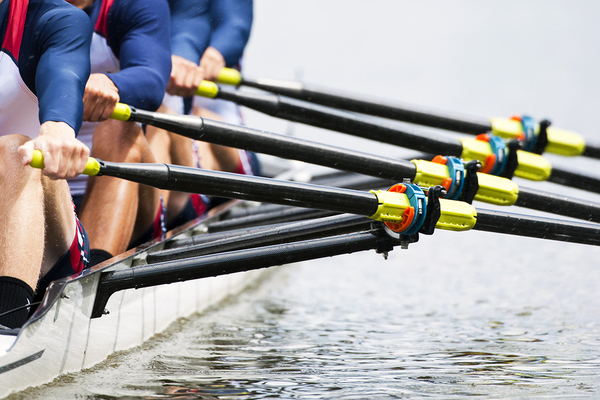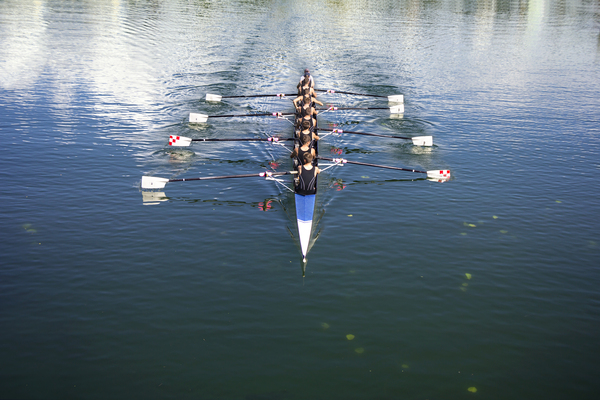Rowing made its modern Olympic debut in 1900. It wasn’t until 1976 at the Summer Olympics in Montreal that women’s events were introduced, but men’s and women’s events have enjoyed recognition and respect ever since.

A rowing crew in perfect harmony is a thing of beauty and power.
At the 2016 Summer Olympics in Rio, fourteen different rowing events are being offered, including Men’s, Women’s, and weight-restricted Men’s and Women’s events. If you have ever watched a rowing event, you were probably struck by how mesmerizing it is to watch, and by how the vessel, crew, and oars all become almost a single organism, propelling itself through the water with grace and speed. It turns out we can learn a lot about team building from Olympic rowing events.
What the Athletes Do
During rowing, the crew faces the stern of the boat. Oars held in place by oarlocks are used in unison to propel the boat forward toward the bow. Rowing events may take place on many types of water bodies, including lakes, canals, rivers, and seas. Doing it successfully requires that every athlete on the crew possess physical strength, endurance, flexibility, and balance. Rowing events include endurance races, time trials, stakes races, and side-by-side races, like those in the Olympics. One reason for so many variations is the sport’s long history. Rowing developed as a mode of transportation in several regions of the world, each with its own specifics.
Basically, however, there are two main types of rowing: sweep and sculling. In sweep-oar rowing, every rower has one oar, which he or she holds with both hands. Crews are usually 4-person or 8-person. In sculling events, each team member has two oars (sometimes called sculls) – one for each hand. With 8-person crews, the crew includes a coxswain, which is a team member that faces the rest of the team and orchestrates the rhythm and motions of the rest of the team.
Each stroke has two important time points to it. The “catch” is when the oar blades are placed in the water, and the “extraction” is when it is removed from the water. It’s analogous to the work a team does to propel a project forward. In theory, it’s simple, but in practice, excellent teamwork is required.
Rowing and Teamwork

With larger crews, a coxswain is tasked with coordinating team motions.
In its quasi-steady state, the motion of the whole rowing “organism” (boat, rowers, and oars) is repeated regularly and must be done in perfect coordination for the best results. Clearly, team building is an essential component of successful rowing. When you watch rowing, your eye is naturally drawn to the churning water and oars slicing through the water, but make sure you also appreciate the amazing synchronicity of the team. Every team member’s every motion must be efficient, coordinated, and timed perfectly, with boat, oars, and limbs moving in precise rhythm.
If you ask rowers about their experience, you’ll find that many of the memories and lessons learned have to do with teamwork. Without teamwork, a rowing crew won’t have the trust, commitment, selflessness, honesty, and determination to excel. It’s clear that rowing affects crews both mentally and physically, because transcending their own ego is necessary to devote themselves properly to the crew effort. The result is an extremely physically demanding sport that requires working in proximity and coordination with others as a single unit.
Does Your Team Have “Swing”?
Team building exercises in corporations are nothing new, and much can be learned from rowing, which is perhaps the ultimate team sport. Everyone is literally pulling in the same direction, and while there aren’t really “stars” in rowing the way there are in, say, track and field events, there’s no place to hide either. Every team member is expected to contribute, and those who don’t can’t dodge their responsibilities and expect success. It can take months of practice for an 8-person crew to achieve the collective rhythm, consistency, and pace to succeed in rowing events.
Team building is an apt topic to study in an Olympic year, and there’s no better example of it than with the rowing crews in Rio. It’s a shining example of how unique individuals can work together to create something better and more powerful than the sum of its parts. At Teams of Distinction, we call this transcendent state “swing,” and we show companies like yours how to attain that level of team-building.